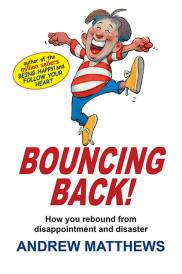Michelle Williams, Seth Rogen, Take This Waltz
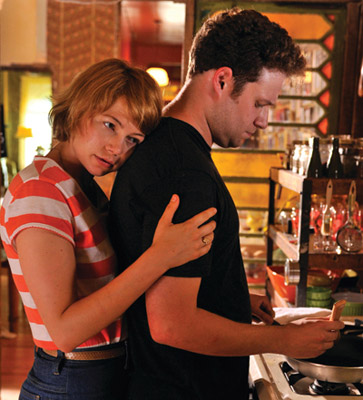
Take This Waltz
Cast: Michelle Williams, Seth Rogen, Luke Kirby, Sarah SilvermanDirector: Sarah Polley
Running Time: 116 minutes
Synopsis: When Margot (Michelle Williams), 28, meets Daniel (Luke Kirby), their chemistry is intense and immediate. But Margot suppresses her sudden attraction; she is happily married to Lou (Seth Rogen), a cookbook writer.
When Margot learns that Daniel lives across the street from them, the certainty about her domestic life shatters.
She and Daniel steal moments throughout the steaming Toronto summer, their eroticism heightened by their restraint. Swelteringly hot, bright and colourful like a bowl of fruit, Take This Waltz leads us, laughing, through the familiar, but uncharted question of what long-term relationships do to love, sex, and our images of ourselves.
Release Date: June 14th, 2012
Production Notes
Take This Waltz begins with heat. Margot is baking muffins in the sweltering humidity of a Toronto summer. Heat radiates from the oven, sunlight filters through the windows, and as Margot leans up against the stove, the film becomes a sensory experience. Take This Waltz is the second feature film from writer/director Sarah Polley, based on her screenplay which made the coveted Black List in 2009. Whereas Polley's feature film directorial debut, Away From Her, was the tender story of a couple in the winter of their married life, Take This Waltz follows a younger couple, married for only a few years, moving from the springtime of their romance, settling into what should be a warm, loving life together.Set in Sarah Polley's hometown of Toronto, she proudly admits that she romanticises the city, and wanted to show her affection for the tree-lined streets and downtown residential areas tucked in around neighbourhood restaurants and cinemas. So she placed the story right onto the sidewalks, streetcars and beaches which she walks every day.
The title of the film, Take This Waltz, comes from the Leonard Cohen song of the same name, the words of which Cohen interpreted from "Little Viennese Waltz" by the modernist poet, Frederico Garcia Lorca, who was assassinated in 1936 during the Spanish Civil War.
Now in Vienna there's ten pretty women. There's a shoulder where Death comes to cry. There's a lobby with nine hundred windows. There's a tree where the doves go to die.
"The lyrics are so tragic and romantic," declared Sarah Polley. "You never completely understand it, but it makes perfect sense on some deep, emotional level. I listened to it non-stop while writing the screenplay and it informed the tone of what I wanted to accomplish."
In the story, Lou is the good husband, durable in his affection for his wife, grounded in his kitchen, as he diligently works his way through his chicken recipes; Margot, however, is a zephyr. Temperate in her self-awareness, untethered by intention, she is easily propelled by gusts of inspiration coming from others. Side by side, making all the proscribed choices young, urban couples are advised to make, they move towards their future. Lou, contentedly - Margot, because she is his wife.
For Sarah Polley, this opening scene in the kitchen, domestic, yet dull, approaching claustrophobic; peaceful, yet intensely restless, is a bookend for the film. "I start and end the film with this scene, even though a great deal goes on in between," said Sarah Polley, "I wanted to make a film about desire, not a philosophical essay, but to be inside of it, to feel how delicious it is, and how difficult it is for us, as human beings, to either turn our backs on that sensation or to live with the primal gap it creates, one that needs to be fulfilled. I wanted to show the process of someone trying to escape that essential state of being and how it doesn't always work."
In many respects, Take This Waltz is a coming of age movie about a woman in her late 20s, for whom the veil concealing the reality of romance and relationships truly falls away, revealing an emptiness that cries out to be addressed. "For women like Margot, and most women I know in their 30s," said Sarah Polley, "there is a point when they realise the 'happily ever after' relationship fairytales they were told about as a child are not quite true. If you're lucky, there is a great love, but apart from that, how do you know if a relationship is 'wrong' or if needing/wanting/desire is a function of life being complicated? It's not simple. You may be in a relationship where you are mostly happy, but also sad or angry - and nothing prepares us for that."
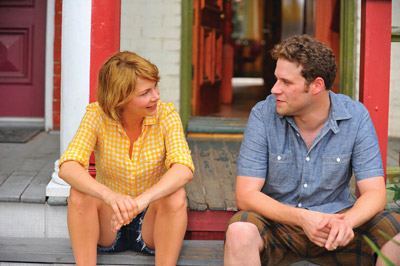 The emotional reality of relationships is complicated by the pervasive happiness imperative that runs through our lives. Relationship guidelines abound in books, magazines and online, dictating the levels of happiness we should be experiencing with our partners: are your needs being met? Can you communicate? Do you still laugh? Do you still enjoy being alone with them? Can you still overlook minor annoyances? Sarah Polley weighs in on this subject: "I think we live in a culture where if there is something missing in a relationship, then there is something wrong. It can be fixed, we are told, and it's a failure to not fix it," she said.
The emotional reality of relationships is complicated by the pervasive happiness imperative that runs through our lives. Relationship guidelines abound in books, magazines and online, dictating the levels of happiness we should be experiencing with our partners: are your needs being met? Can you communicate? Do you still laugh? Do you still enjoy being alone with them? Can you still overlook minor annoyances? Sarah Polley weighs in on this subject: "I think we live in a culture where if there is something missing in a relationship, then there is something wrong. It can be fixed, we are told, and it's a failure to not fix it," she said. The honeymoon period of Margot and Lou's marriage is over. Their fifth anniversary dinner scene at the restaurant, where they struggle to converse, poignantly highlights this. As the novelist, Robert Louis Stevenson, wrote, the cruellest lies are often told in silence. "There are very few couples who are completely engaged and fascinated by each other years into their relationship," noted Sarah Polley. "Once you know someone that well, it's hard to have the space between you to be interested and excited by each other's company."
Margot copes with this by adopting slightly baroque behaviour: irregular in its rules, swinging wildly between baby talk, verbal jousting and perfunctory sex. Lou, who is having a hard time following her playbook, takes the passive approach. "Lou has a belief that if you don't address something head on with words, it has a chance of just going away. I understand why he wants to avoid conversations. From an outside perspective, it's so obvious that talking about the problem would be the better thing to do, but in an intimate relationship, it's the scariest thing in the world to admit that there might be something insurmountable there," explained Sarah Polley.
The marriage isn't enough for Margot, but for Sarah Polley, the question becomes, "Is anything really enough? My wish is that throughout the film, people will not know what Margot should do and they'll bring their own lives into the decision. There's a tremendous amount of ambiguity in the film. For people who left a stagnant relationship and it was the right decision for them, I hope they'll feel this film supports that. For those who have turned away from temptation, and stayed in a relationship, I hope this film will act as a confirmation that this was the right choice as well."
Enter Daniel
"Originally, Daniel was the object of desire, the thing that makes you question your life," said Sarah Polley about this character who lands, ironically, right across the street from Margot's life. The object becomes a catalyst. "From Margot and Daniel's point of view, it's very, very hard to turn away from falling in love and very few people can do it." The dizzying head-over-heels tumble into love is something Sarah Polley feels offers lovers the idea that they will be able to reinvent themselves with this other person in a way they were unable to do alone. It affords lovers a state of fulfillment that seemingly exists only in combination with this person.
Ultimately, Sarah Polley believes that we are not satisfied beings. "We need. We want. And we desire. And that's part of who we are. You get to the point you've been longing for and then, inevitably, another chasm opens up. I feel these characters are people who mean well and are doing their best, but their best sometimes isn't good enough for the other characters - the way it is in life as well," she explained.
Bringing Sarah Polley's Screenplay to Life
Take This Waltz is produced by Sarah Polley and Susan Cavan. "Sarah Polley found me in 2009 and showed me the script. This was exactly the kind of material I wanted to be doing," said Susan Cavan, a veteran in the industry. "It's provocative, unique, humourous in places, sad in places, and complicated."
For Susan Cavan, her priority as producer was to provide a safe space within which Sarah Polley and her actors could work. "The best realised movies, especially for auteur filmmakers like Sarah Polley, benefit most from an absence of interference, crisis and chaos. This is an intimate movie, very nuanced with an emotional underpinning to it. To be able to deliver this successfully, the production was structured with a handpicked, first class crew who had a like-minded approach to the project.
Sarah Polley is an enormously talented, perceptive director who is both completely unafraid to explore things that on the surface appear simple. This pertains to both Away From Her and Take This Waltz. She is very clear in what she wants, possibly one of the clearest communicators I've ever met."
Michelle Williams
When the story begins, Margot, 28, is a writer who has not written much. Her husband is a cook, creating recipes for an all chicken cookbook. Lou, coming from a solid, supportive family, is kind and adorable. "Lou makes her feel contained," Michelle Williams observed. "He makes her feel cozy, safe, secure and a little drowsy. Take This Waltz is about Margot on the threshold of moving from being a girl, where it is safe, to a woman, where there are no guarantees. It's like she's trying to hang onto something she's losing her grasp on - all subconsciously of course."
A two-time Oscar-nominee, Michelle Williams is more apt to emotionalise her roles rather than intellectualise them. After working with Seth Rogen, she had a heartfelt reaction to how their characters interact. "Knowing him and seeing his performance, I thought, 'How am I going to walk away from this marriage? He's so loveable!' Yet, looking out at the world from Margot's viewpoint, she wonders if she's missing out on life and if something's going to pass her by. Margot feels stuck. She's not doing exactly what she wants to be doing. She's not writing exactly what she wants to be writing." In building this character, Costume Designer Lea Carlson found there to be something gentle and slightly quirky about her, but intentionally didn't want her to be too sweet. She just slips on a pair of sneakers and, Margot being Margot, everything looks cool in a haphazard, unplanned way.
Contentment can be as deceptive as desire. When Daniel comes along, Michelle Williams sees it as being like a shot of adrenaline for Margot. "I think that falling in love is the closest thing to a religious experience that you can have in Western culture," she professed. "It's such a gentle thing that causes such a great upheaval in your life, rearranging your morals and your values." It certainly was the justification Margot used to motivate herself forward, but whether it was real, or simply real enough for her, is the question because Daniel becomes the vehicle for her hopes and dreams and ambitions. "It's like Daniel is a place for Margot to put it all," explained Michelle Williams.
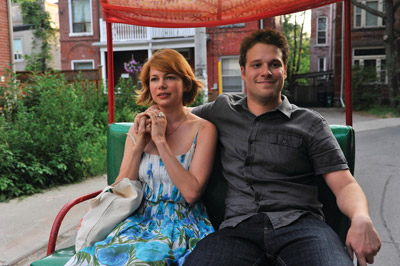 It is here where the magic of performance becomes genuine because both actor and character embrace the freedom of ambiguity Sarah Polley has written into the script and move forward with optimistic hope. Michelle Williams shied away from verbalising how Margot makes her final decision, instead saying, "Does she want more or is she writing it off as something sexual that she wants to explore with Daniel? I hope she's following her heart, her best heart, her most noble heart. We don't know if it's a mistake or not." The question is, does anyone ever know.
It is here where the magic of performance becomes genuine because both actor and character embrace the freedom of ambiguity Sarah Polley has written into the script and move forward with optimistic hope. Michelle Williams shied away from verbalising how Margot makes her final decision, instead saying, "Does she want more or is she writing it off as something sexual that she wants to explore with Daniel? I hope she's following her heart, her best heart, her most noble heart. We don't know if it's a mistake or not." The question is, does anyone ever know. "Margot evolved inside me slowly," acknowledged Michelle Williams. "To me, Margot starts out the movie as an innocent. At first I wondered if she was someone to whom nothing bad had ever happened, and this breakup was her first kind of experience into her shadow-self. Maybe it was her walk on the wild side. But that evolved and now I don't think she's entirely naïve - but she does have a kind of unworldly-ness about her so that this experience is a transformation. That's a good thing, but it's transformation through fire, which is painful."
Seth Rogen, whose movie relationships have typically been about either meeting or breaking up with a girl, found the 'happily married' relationship completely novel. "It was really interesting pretending to be married to someone all day. It's amazing how easy it is when you're allowed to be comfortable with yourself when the cameras are rolling - and how awkward it becomes the second they stop rolling. But Michelle Williams made it as easy as it could be, and she's just 100% real at all times. Because it feels kind of real at times and Michelle Williams's so nice, it just sucks to have to even pretend to not get along with her."
Prior to Take This Waltz, Michelle Williams has what some would call an interesting, albeit imaginary relationship with Sarah Polley. "This has really has been sort of a dream come true. I told Sarah Polley "You know what I do sometimes before I act, before I met you? I do WWSPD: What Would Sarah Polley Do?" You know when you're on take #10 of a scene and you still haven't found your way in, nothing's clicking, and you're calling upon the gods for some sort of help? One of my pull-it-out-the-bag things is, 'How would Sarah Polley do this scene? What would she do?'"
Even from afar, the respect was reciprocated. Sarah Polley assessed the talent of Michelle Williams succinctly, "I think Michelle Williams is the greatest actor of her generation and that's not a superlative. What I learned from working with her is the difference between good actors and great actors: great actors don't just surprise their directors or their audience - they surprise themselves. Something about their character blindsides them in the middle of a take and their performance spins off a bit in an incredible, unforeseen direction." So transcendent was Michelle Williams' performance that Sarah Polley was better able to understand the character she created, and, as a result, was able to allow Margot to travel further in her emotional journey. "Michelle Williams has such wisdom about her, such poetry about her, it was hard to keep a character in the same place if it is Michelle Williams who is playing her."
Seth Rogen
In the chicken-egg world of deciding to take a role because of the script or because of the director, Seth Rogen had not read Take This Waltz before meeting Sarah Polley on the set of The Green Hornet. "She came to LA and told me about the film. She was so nice and so cool. I'd actually been a big fan of hers for a long time, both as an actor and director. And then I read it and thought it was really awesome and very well written, much better written than I can write," Seth Rogen laughed at his admission. "So I was very thrilled to do it, and yeah, I was very excited."
Seth Rogen, who tends to think of everything in terms of humour, regards the perspective of his character as amusing. Lou is, for the most part, completely unaware of what is happening around him. "For Lou, Take This Waltz is a movie about a guy who writes a chicken cookbook and then finds out his wife is cheating on him. It's kind of funny that my character is just not that emotionally involved." Seth Rogen is more familiar with cynical characters who are in on the action, albeit not necessarily in the brightest way possible. But he played Lou "as comfortable. He's just making his chicken and everything is fantastic."
"I did draw on my Dad a little for this role, honestly," he admitted. "My Dad does a thing where he talks with his eyes closed, so I did that a few times."
But getting back to the chicken, Seth Rogen viewed it as, "Slightly symbolic for a guy who's aspiring to do something, but not something that's incredibly exciting or daring. Chicken is the middle ground of meat. It's a good metaphor for the relationship. It's good, but it's not the most exciting thing in the world."
What was exciting was the prep. "I can confidently say I did more research for this movie than any movie I've ever done, except maybe Pineapple Express. You learn little things from movies, like how to ride a motorcycle or shoot an AK-47. But for Waltz, I spent a lot of time learning how to cut up chickens. I had chefs coming to my house in LA and they'd leave me dozens of chickens. I'd cut them up and cook them in different ways, but I would mostly just cut them up. I'd also watch a lot of cooking shows, like Top Chef, and steal the way they do stuff." Seth Rogen was so into his prep, he started having chicken dreams, but confused his chicken-sized Cavalier King Charles Spaniel for the food. "That was weird."
That said, his wrap gift from the film crew was a magnificent set of carving knives. All reports indicate the dog remains in good health.
While Sarah Silverman, who played Lou's sister, Geraldine, was dreading the naked shower scene, Seth Rogen had to deal with the scene which has come to be known as 'The Storm.' It is when Lou faces the truth about the state of their marriage. "It was pretty brutal, but we did it."
"It was about emptiness and emotional lost-ness and a void. When I look at comedy, I can feel if it's funny or not. But when it's all based on nuanced emotional moments, it's a lot harder to gauge whether or not I'm doing a good job. In some ways, I thought it was a lot harder than comedy."
"The entire scene was primarily scripted with a healthy blend of ad-lib," said Cinematographer Luc Montpellier. "Sarah Polley only stopped to reload the camera every half hour or so. Only key crew remained on set to give Seth space to breathe."
"This scene was all on his strong shoulders," said Michelle Williams. "The camera was not on me, so I was improvising off camera, but he was doing it all on camera. Leading up to this, Seth Rogan and I had found a nice rhythm together. It's nothing we had planned on, but just accidentally Sarah Polley would keep the camera rolling after a take and that became a habit that at the end of each scene. I had my crash course in improv on Blue Valentine, so I've gotten more comfortable with it. But Seth Rogan rewards your efforts with his hardy laugh. He's just such a deeply generous guy."
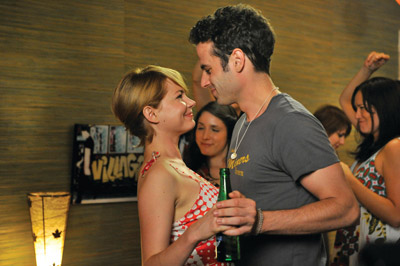 "Seth Rogan is such an easy-going person," Sarah Polley declared. "I've never encountered anyone that comfortable in his own skin. He's got this light touch about being in the world that I envy so much. He happens to be really funny, but everything I have seen him in, he has always done extraordinary acting. From the moment I wrote Lou, (the character I identify with the most) I always knew it was Seth Rogan."
"Seth Rogan is such an easy-going person," Sarah Polley declared. "I've never encountered anyone that comfortable in his own skin. He's got this light touch about being in the world that I envy so much. He happens to be really funny, but everything I have seen him in, he has always done extraordinary acting. From the moment I wrote Lou, (the character I identify with the most) I always knew it was Seth Rogan." Luke Kirby
Luke Kirby first met Sarah Polley in 2002 when they both starred in Peter Wellington's film, Luck. "Now she's the boss," he said. "And it's incredibly lovely. I have a very strong sense with Sarah Polley that if she isn't feeling that we have gotten to where we want to be in a scene, she won't relent, she won't settle. I feel a sense of trust and it's exhilarating. She's like a very strong little bird in a breadbasket who you'd like to take with you on your picnic. She's very calm and grounded and present. Those qualities are exceptional. There's no concern of being embarrassed because of whatever truth she carries."
Playing Daniel just felt right to Luke Kirby. Daniel is an artist, a solitary man who finances his art life by pulling a rickshaw. Once he meets Margot, everything changes. "The relationship between them is a force too strong to even acknowledge any question of integrity. He knows she is married, but there's not enough space for him to think about it, and he's not blind to the spark. It's too exciting. It feels too good to stop and assess because of the game they are playing which, for the most part, is unconscious - that is until the depth of it and the reality of it hits, which it does, heavily. It seems free at first, but there is a price tag. It is too frightening to acknowledge that there may be some kind of loss."
There was a happy ease for Luke Kirby moving into playing this role and that had a lot to do with the extensive rehearsal time allotted prior to shooting. "I enjoyed the process mostly for the environment Sarah Polley created, putting us all together. I was very happy just being in a room with Sarah Polley and Michelle Williams and having the space to play and not being at the behest of time constraints," he said.
The rehearsals included everything - except the martini scene.
57 Int Café/Bar - Afternoon
They sit facing each other - untouched martinis in front of them.
DANIEL: Drink.
MARGOT: You drink.
DANIEL: You first.
MARGOT: I don't want to get drunk with you.
DANIEL: I'm impressed by your consistency.
MARGOT: I want.
DANIEL: You want.
MARGOT: I want to know...
She looks up, bright red.
MARGOT (CONT'D): I want to know what you'd do to me.
This scene, which continues on to become brazenly explicit, in spite of both actors remaining in public and fully dressed, was a moment of Machiavellian directing. "It was the first time those actors has spent much time with those lines and it was shot on the very first day right after lunch. I think it helped that there was real embarrassment and real awkwardness about that. And yes, I did that deliberately," Sarah Polley stated.
"The martini scene anchored something deep between those two," said Luke Kirby, "and that only came up in the doing of it. We were vulnerable that day, but it all feels so vulnerable, always. I couldn't ask for anyone better to play with in this regard. Michelle Williams is entirely there. It's very easy to smile with her. When I first read the script, I thought, they sure laugh a lot. And it's very rare that you read 'laughter' written into a script and it's everywhere. And I thought it could be difficult, but it wasn't."
When asked about working with Luke Kirby, Michelle Williams said, "Each time I'm worried about a scene and how I'm going to approach it, I was comforted when I looked into Luke Kirby's eyes and realised, 'Oh, I can just relate to what he's offering me.'"
It was this very point that caused Sarah Polley to say that Luke Kirby did an incredible job of making that role into a lot more than she originally imagined. "Luke Kirby has played eccentric characters, but there is a striking purity and a kindness to him."
Daniel's art is that of Balint Zsako, crisp in contrast to the humid palette of Margot's life, suggestive, in the spirit of both Inuit art and Aubrey Beardsley's erotica, again contrasting the submerged sexuality of Margot's existence. A native of Budapest, now living in New York, Balint Zsako works in several media: collage, sculpture, photography and machines, but for Take This Waltz, Sarah Polley selected his bright water colours of surreal almost mystical hybrids of humanity rendered with exaggerated sexual and fertile qualities.
Luke Kirby did spend some time with the artist in New York. "His work is quite stunning, very beautiful and sensual without being crass. As a person, he was very giving in terms of welcoming me into his home, sharing his process and his work." There was one distinct point of overlap between the real artist and the character in the film - both are hesitant about showing their work and Balint Zsako was surprised that Daniel shared the portrait with Margot. Kirby could only explain it by way of the script when Daniel says to Margot, 'There was something about your face that made me want to start talking to people again.'"
Sarah Silverman
"I'd never get read for a part like this," Sarah Silverman pronounced upfront. Unquestionably, the role of Geraldine is casting against type in the extreme and it is an unabashed masterstroke on the part of both Sarah Polley and casting director John Buchan. Sarah Silverman elaborated, "Usually when I'm told that someone had me in mind for a part, it's vulgar and it has shit jokes and it's gross. It must be what I put out there, but I don't see myself like that. But when I read this, I got choked up because I couldn't believe someone would see me this way. I see myself able to play drama. But we put people in boxes and can't see outside of it, but Sarah did. It was so nice. And I'm so grateful for this."
Geraldine is Lou's sister. She is also a recovering alcoholic. While Margot is surrounded by the comfort of Lou's sprawling family, Geraldine is the only one with whom she shares any personal thoughts. "Margot is like a little sister to Geraldine, although she does view Margot in the context of protecting Lou's happiness. I also think there's a self-centeredness in both characters where they're connecting but only because they're getting something that they need or giving something that they need to give. Like many friendships, theirs is like two islands in a way - Geraldine has her own shit and she's seeing everything around her in relation to her own shit, and so is Margot," explained Sarah Silverman.
And to be working with Sarah Polley, Sarah Silverman declared, "So many directors, great directors, directors I love, are fully socially retarded. Sarah Polley actually isn't. She has a plan, knows exactly what she wants, and knows how to manipulate exactly how to get it in a way that makes you, the actors and me, feeling like "Oh my God, I'm amazing in this!" instead of shells of ourselves."
"Sarah Silverman is my favourite living performer and has been for years," stated Sarah Polley. "You know the "If you could have dinner with one person in the world, who would that be?" question? For the last five years, the answer has always been Sarah Silverman. The moment her name was suggested by John Buchan, it was all hands on deck to get her. As much as I knew she was going to be fantastic in this part, nothing could have prepared me for how complicated and nuanced and strange and beautiful her work was. It was such a joy to watch her work."
The part of Geraldine is that of the proverbial Greek chorus, the wisest character in the film even if her life is a bit of a mess. The key to this wisdom is the cross she bears throughout the film, her alcoholism. "That state of 'needing, wanting and 'won't survive unless you have it' is something that an addict is very familiar with," continued Sarah Polley, "and they understand what a trap it can be, what an illusion. The rest of us struggle to understand this in increments. As a result, Geraldine recognises in Margot the qualities of needing a drug, except in Margot's case love and filling emptiness are more organic to her life. Geraldine tried in vain to fill the emptiness as well - she just does it with something else."
The progression of shifting from comedy to drama is a subject of perpetual interest to viewers because the funny- actor-turned-serious-actor has to convincingly take audiences, and their previous conceptions, along for the ride. Sarah Silverman is adamant that the key to the transition is honesty in performance. "To me, Seth Rogen is the marker of where comedy started being played very real. It was like the anti-Ace Ventura (which was great when it came out). It's just playing it real and letting the moments be funny. So watching Seth Rogen go from comedy to drama is seamless because he's just playing the lines very naturally in both cases. There's no difference."
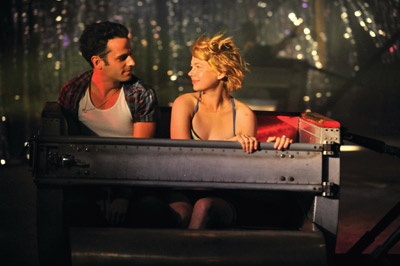 Seth Rogen wasn't quite as convinced. "With comedy, for me, you develop a pretty good gauge of whether it is funny or not. The kind of comedy that we generally have done is naturalistic, conversational, which means it's not like completely based on call-and-response. But I also thought that when you find out what's happening to Lou and to Margot, it's very impactful and there are a lot of really interesting moments that I'd never really seen in a movie before. More than anything, Sarah Polley really seemed to think I was going to help her movie a lot and that to me was the most important thing."
Seth Rogen wasn't quite as convinced. "With comedy, for me, you develop a pretty good gauge of whether it is funny or not. The kind of comedy that we generally have done is naturalistic, conversational, which means it's not like completely based on call-and-response. But I also thought that when you find out what's happening to Lou and to Margot, it's very impactful and there are a lot of really interesting moments that I'd never really seen in a movie before. More than anything, Sarah Polley really seemed to think I was going to help her movie a lot and that to me was the most important thing." A Bowl of Fruit
Sarah Polley brought producer Susan Cavan and Luc Montpellier, her Director of Cinematography, with whom she worked on Away From Her, in after the first draft of the script. "As the project evolved, Sarah Polley folded her key creative people into the process so her vision became a shared vision. In the case of Luc, alone, he was brought in far earlier than cinematographers are normally engaged. She is meticulous in her planning, and she and the actors had extensive rehearsals - often right on the sets the scenes were to take place. That kind of comprehensive familiarity allows for improvisation, such as with the party scene which was heavily choreographed, but still had a looseness and imperfection that produced a very creative result," said Susan Cavan. Sarah Polley has indeed turned imperfection into an art form. "You could walk out of this film and feel quite good about yourself because you don't know and are unsure, are imperfect and unfinished and have grafted your own experiences onto any one of the characters. It happens subtly throughout the film, and you come out breathless."
"One of the first mandatory attributes of the film, in addition to the "bowl of fruit" motif, was that Sarah Polley declared it be shot at the height of the summer in sweaty, hot downtown Toronto," said Montpellier. And after two consecutive summers of cool and wet weather, the jet stream shifted north, allowing warm air from the Gulf to flow at record-breaking levels. Muggy, soaring temperatures were capped off by Hurricane Earl, which made landfall in Nova Scotia, the film's second location, just after 35 days of principal photography wrapped.
In an effort to create a visual language for the film, Sarah Polley and Luc Montpellier, with the contribution from a graphic artist, Jessica Reid, began trading images among themselves. "There were a lot of summer city images, paintings with a tremendous amount of chroma in them, a lot of primary colours and night images. On a subconscious level, we always picked images with some kind of wetness to them where you could feel the heat within the frames," recalled Luc Montpellier. "In the end, this is what the film ended up having which is quite a victory when your original intention is actually reflected in the film."
All the creative and visual decisions came from the characters, an organic design strategy which is a function of bringing the creative team in early in the process. "Margot and Lou live together in a wonderful life," Luc Montpellier continued, "but there is something slightly missing in their relationship. So the world of colour and warmth is a celebration of uneasiness as well as satisfaction and every frame needed to tell that story without words." By using a tremendous saturation of colour and working primarily with source light (sunlight) coming in through windows, intruding into interior spaces, which in turn would bounce off objects, floors and ceilings in frame and then washing over the actors, everything appears honest and true to itself instead of looking artificially lit.
Light and heat coming into Margot's home and life is a metaphor for what takes place throughout the story and Montpellier strove to duplicate the poetry of the screenplay on the canvas of his cinematography. The backlighting of Lou during 'the Storm' scene reflects the emotion of what is happening to Lou at that moment. "All you need is a clear idea to start and for me, for the production designers, for costume design, for all of us, it is the dramatic point of view from which we all work. Story informed everything."
It was story, specifically the "Storm" scene which made Sarah Polley and Luc Montpellier decide to shot the film digitally. This allowed them to let the camera roll for over two hours continuously. There's an emotional response to images you get when you are able to film them at certain times of the day. Shooting at magic hour (a misnomer because this is the last 15 minutes of sunlight in a day, as well as the first 15 minutes in early morning) was something Sarah Polley wrote into the script. As the sun set on Margot's marriage, it also rose on the potentially new relationship she had with Daniel. "Neither of these scenes would have had the same significance if they were shot at high noon," commented Luc Montpellier.
"For the hero house, where Lou and Margo live, the colours are slightly off prime because I didn't see Sarah Polley's 'bowl of fruit' as being fresh, but rather sticky and over ripe," remarked Production Designer Matthew Davies. "I wanted a sense of heat building up in the house, slightly oppressive, with a treacley, beautiful amber light filtering through the windows. This is in direct contrast to Daniel's apartment which is bright white with high key, primary colours."
As envisioned by Sarah Polley, the hero house in Toronto's Little Portugal (which is the scripted neighbourhood) is a fine example of real estate as biography, embodying the spirit of Queen West: a liberal, independent middle class couple would have bought the place when the market took a momentary downturn and then began extensive renovations which dragged on. "Unfinished, like everything else in Lou and Margot's life," continued Matthew Davies. "So we see the uneven surfaces, exposed wiring and peeling plaster. Textured surfaces play light in an interesting way so we used grass wallpapers, a shiny, leather sofa, which has a sticky quality and the coffee table made from samples of linoleum. The colours are oranges, greens and a nicotine- khaki." The interior walls of the house are a very saturated, hot, apricot colour and is further intensified by installing amber and lilac glass panels which pick up shafts of exterior light shining through into the house through patterned gobos, lace sheers and wicker blinds. And in every room are oscillating fans. The effect of heat is a result of layer upon layer upon layer of architectural detail."
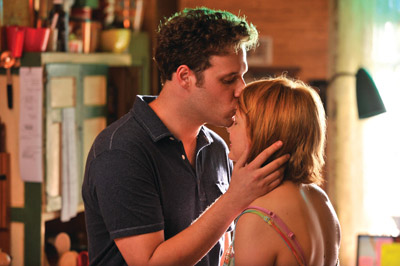 Matthew Davies furnished the house with vintage pieces, re-appropriated from other sources. The art on the living room wall, created specifically for the film, is a photographic triptych of seven graffiti artists (mostly kids from a city project) at one Toronto streetcar stop. This piece is made more significant as a result of the agenda of the new mayor of Toronto, Rob Ford, who had that particular wall painted over a few months after the film was completed. This is also the same streetcar stop in the scene where Daniel, with his rickshaw, passes by Margot.
Matthew Davies furnished the house with vintage pieces, re-appropriated from other sources. The art on the living room wall, created specifically for the film, is a photographic triptych of seven graffiti artists (mostly kids from a city project) at one Toronto streetcar stop. This piece is made more significant as a result of the agenda of the new mayor of Toronto, Rob Ford, who had that particular wall painted over a few months after the film was completed. This is also the same streetcar stop in the scene where Daniel, with his rickshaw, passes by Margot. "To say Sarah Polley is collaborative doesn't do justice to her approach. Sarah Polley is very multi-layered and cultivates very healthy relationships with the crew, allowing everyone to feel like they are a part of the project, to invest themselves in it, and bring something exceptional of themselves to the film," explained Matthew Davies.
"Life has fantastic moments of absolutes, moments where you believe absolutely something, and those moments should be really enjoyed," concluded Sarah Polley. "My general belief is that every decision is ambiguous and it is rare that a decision is clearly right or wrong. Sometimes it can feel that way and those are interesting moments that stand out for me. But I think we are all just muddling through. You never know how a decision will end up so you never know what the right one is. To me, the only real truth is in ambiguity."
MORE
- Mission: Impossible Fallout
- Glenn Close The Wife
- Allison Chhorn Stanley's Mouth Interview
- Benicio Del Toro Sicario: Day of the Soldado
- Dame Judi Dench Tea With The Dames
- Sandra Bullock Ocean's 8
- Chris Pratt Jurassic World: Fallen Kingdom
- Claudia Sangiorgi Dalimore and Michelle Grace...
- Rachel McAdams Disobedience Interview
- Sebastián Lelio and Alessandro Nivola...
- Perri Cummings Trench Interview


